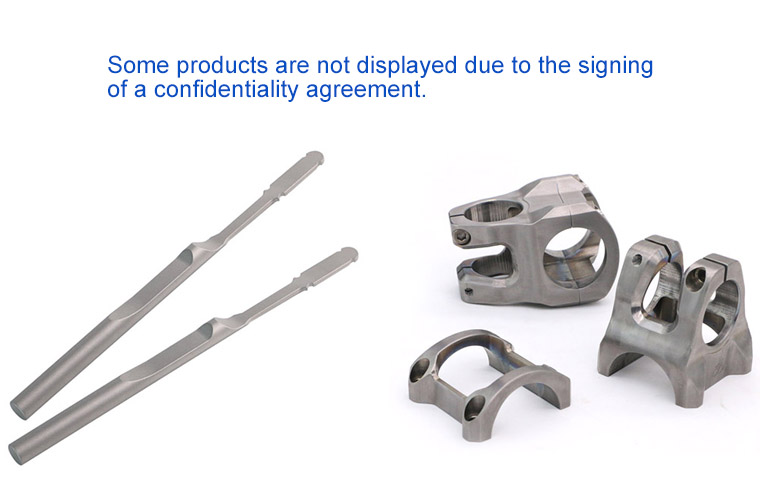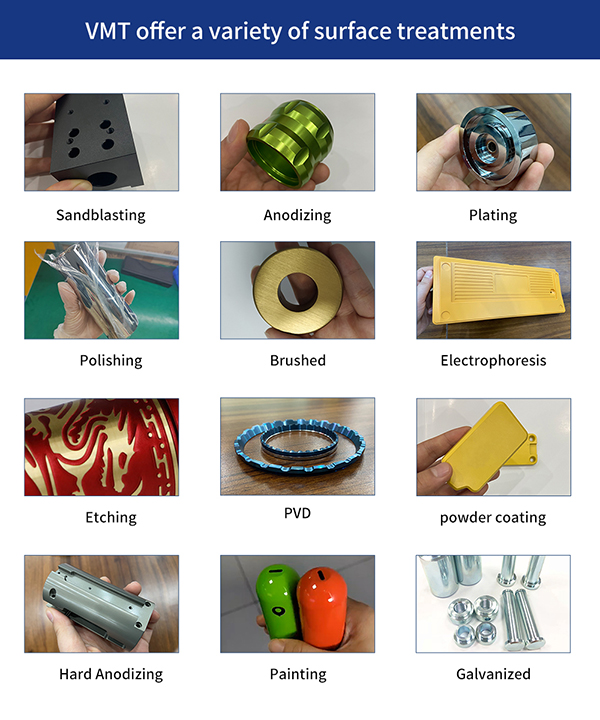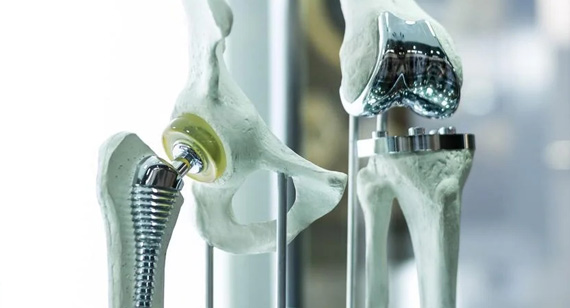15 years one-stop China custom CNC machining parts factory
 180 |
Published by VMT at Sep 14 2024
180 |
Published by VMT at Sep 14 2024
Titanium CNC machining is a specialized manufacturing process used to create high-precision parts from titanium alloys. Known for its strength, durability, and corrosion resistance, titanium is widely used in industries such as aerospace, medical, automotive, and marine. However, the process of machining titanium comes with unique challenges due to its chemical properties, high reactivity, and heat generation during cutting. This guide will provide a detailed look into why titanium is chosen for CNC machining, the challenges involved, practical tips for success, the various titanium grades, and the most effective tools and techniques for machining this metal.
Titanium is one of the most sought-after materials for CNC machining due to its impressive range of properties that make it ideal for high-performance applications. The metal is lightweight yet strong, with a high strength-to-weight ratio that makes it particularly valuable in industries such as aerospace and automotive, where reducing weight without compromising strength is critical.

Durability: Titanium is renowned for its durability, resisting fatigue and wear even in demanding environments. It maintains its structural integrity over long periods, making it suitable for parts that undergo constant mechanical stress, such as aerospace components and medical implants.
Non-magnetic: Titanium’s non-magnetic nature makes it a great option for sensitive applications, such as in medical devices and electronic components where interference with magnetic fields must be minimized.
Non-toxic: Titanium is biocompatible, meaning it does not react negatively with human tissues or fluids. This makes it an excellent material for medical implants, including dental and orthopedic devices.
High Strength: Titanium’s tensile strength is comparable to many steels while being significantly lighter. This allows for the creation of strong but lightweight parts, making it ideal for high-performance engineering projects.
Corrosion Resistance: One of titanium’s standout features is its exceptional resistance to corrosion, even in harsh environments like seawater. This property makes titanium an essential material for marine and naval applications, as well as for chemical processing industries.
Good Strength-to-Weight Ratio: Titanium has one of the highest strength-to-weight ratios of any metal, making it indispensable in industries like aerospace where every gram matters in terms of fuel efficiency and performance.
Ductility: Titanium has good ductility, which allows it to be formed and machined into complex shapes while retaining its strength and other mechanical properties.
Good Machinability: Although titanium is often viewed as a difficult material to machine, with the right tools and techniques, it can be machined with precision. Advances in cutting tool technology and cooling systems have made titanium CNC machining much more efficient.
Surface Treatment Options: Titanium is highly compatible with a wide range of surface treatments, including anodizing, powder coating, and PVD coatings, which enhance its aesthetic and functional properties.
Recyclable: Titanium is fully recyclable, contributing to its popularity in industries focused on sustainability. Parts can be melted down and reformed without losing their inherent properties.
Despite its advantages, machining titanium presents several challenges that must be considered before starting any CNC machining project. Titanium’s unique properties, while beneficial in finished products, introduce difficulties during the machining process.
High Chemical Reactivity and Wear: Titanium’s chemical reactivity, especially at high temperatures, can cause rapid tool wear. During machining, the metal tends to react with the cutting tools, leading to galling and material buildup. This not only shortens tool life but can also compromise the quality of the machined surface.
Heat Build-up and Cutting Forces: Titanium has low thermal conductivity, meaning it doesn’t dissipate heat well during the cutting process. The heat generated by the friction between the cutting tool and the titanium remains concentrated at the cutting edge, increasing the risk of tool failure and poor surface finish. Managing heat build-up is critical to prevent distortion and ensure precision machining.
Residual and Hardening Stresses: Titanium alloys tend to harden during machining due to work hardening effects, which can cause residual stresses in the part. This hardening can make subsequent passes more difficult, requiring adjustments in cutting speed and depth of cut. In extreme cases, these stresses can lead to part warping or failure after machining.
Workholding: Titanium’s high strength and elastic nature make it prone to deflection under cutting forces. Effective workholding strategies are essential to keep the material rigid and prevent unwanted movement during the machining process. Without proper workholding, precision can be compromised, leading to dimensional inaccuracies.
Elastic Deformation: Titanium’s elasticity means that it can flex slightly during machining, leading to chatter and poor surface finishes. This elasticity also means that machining forces must be carefully controlled to avoid pushing the material too hard, which can cause excessive vibration.
Machining titanium requires specialized tools and strategies to address the challenges mentioned above. Here are some practical tips to improve your chances of success when machining titanium alloys:
Securely Hold the Part: Because titanium can flex during cutting, it’s crucial to use robust workholding solutions to keep the part rigid. Ensure that the part is firmly clamped or fixed in place, using fixtures designed to minimize movement during machining.
Choose the Right Cutting Tool: Selecting the appropriate cutting tool is essential for efficient titanium machining. Carbide tools are generally recommended for their hardness and resistance to heat. Ensure the cutting tool has sufficient edge sharpness to prevent material build-up and reduce heat generation.
Consider Cutting Parameters: When working with titanium, reduce cutting speeds to minimize heat build-up. However, maintain high feed rates to keep the cutting action efficient and prevent work hardening. Depth of cut should also be managed carefully to avoid stressing the cutting tool.
Prevent Overheating with High-Pressure Cooling Systems: Given titanium’s poor heat conductivity, using high-pressure coolant is critical. This helps to dissipate heat from the cutting zone and prevents tool overheating. Water-based coolants are preferred for their cooling efficiency and ability to carry heat away from the tool and workpiece.
Titanium comes in various grades, each with different properties that affect their suitability for CNC machining. Understanding these differences is crucial when selecting the right material for your project.
Grade 1 (Pure Titanium, Low Oxygen Content): Grade 1 titanium is the softest and most ductile of the commercially pure titanium grades. It is highly corrosion-resistant and ideal for applications that require excellent formability, such as chemical processing equipment and marine applications.
Grade 2 (Pure Titanium, Standard Oxygen Content): Grade 2 titanium offers a good balance between strength and corrosion resistance. It is commonly used for architectural structures, heat exchangers, and medical equipment.
Grade 3 (Pure Titanium, Medium Oxygen Content): This grade offers higher strength than Grade 2 but retains similar corrosion resistance. It is used in industries that require higher mechanical performance without sacrificing corrosion resistance, such as in aerospace.
Grade 4 (Pure Titanium, High Oxygen Content): Grade 4 titanium is the strongest of the commercially pure titanium grades. It is used in applications where high strength is needed, such as in industrial and medical components.
Grade 5 (Ti6Al4V): The most commonly used titanium alloy, Grade 5 (Ti6Al4V), offers an excellent combination of strength, corrosion resistance, and machinability. It is widely used in aerospace, automotive, and medical industries due to its high performance and versatility.
Grade 6 (Ti 5 Al-2.5Sn): Grade 6 titanium is known for its high temperature and corrosion resistance. It is used in applications that require performance at elevated temperatures, such as in jet engines and heat-resistant structures.
Grade 7 (Ti-0.15Pd): This titanium alloy contains palladium, giving it superior corrosion resistance, particularly in reducing or acidic environments. It is often used in chemical processing and marine applications.
Grade 11 (Ti-0.15Pd): Grade 11 titanium offers the same corrosion resistance as Grade 7 but with improved formability. It is ideal for applications that require both corrosion resistance and ease of forming.
Grade 12 (Ti0.3Mo0.8Ni): This grade offers excellent corrosion resistance combined with moderate strength. It is suitable for use in high-temperature environments such as heat exchangers.
Grade 23 (T6Al4V-ELI): Known for its superior biocompatibility, Grade 23 titanium is commonly used in medical implants and surgical devices. It offers high strength, good corrosion resistance, and excellent fracture toughness.
| Grades |
Description |
Advantages |
Disadvantages |
Applications |
|
| Grade 1 |
Commercially pure titanium with low oxygen content. |
One of the most commonly used grades of titanium. It is the most ductile and the softest titanium alloy. |
Excellent relative formability and machinability, corrosion resistance, and impact toughness. |
Lower strength compared to the other titanium grades. |
Chemical processing, desalination, medical industry, automotive parts, airframe structure. |
| Grade 2 |
Commercially pure titanium with standard oxygen content. |
Pure titanium, known as the workhorse of the titanium industry. |
High corrosion resistance, good weldability, strength, ductility, and formability. High relative machinability. |
Not as strong as other titanium grades, but stronger than grade 1 |
Aircraft engines, hydrocarbon processing, chlorate manufacturing, medical industry. |
| Grade 3 |
Commercially pure titanium with medium oxygen content. |
Grade 3 is the least commercially used, but it possesses good mechanical properties. |
High strength and corrosion resistance. Good relative machinability. |
Less formability than grades 1 and 2. |
Medical industry, marine industry, aerospace structures. |
| Grade 4 |
Commercially pure titanium with high oxygen content. |
Known as the strongest of the four commercially pure grades. |
Very high strength and corrosion resistance. Okay relative machinability. |
Hard to machine, requires slow speeds, high coolant flow, and high feed rates. |
Cryogenic vessels, heat exchangers, CPI equipment, surgical hardware, airframe components. |
| Grade 5 |
Titanium alloy – Ti6Al4V |
This is the most commonly used alloy of titanium. It contains 6% aluminum and 4% of vanadium. |
High corrosion resistance and high formability. Poor relative machinability. |
Less strong than the other alloys. |
Critical airframe structures, power generation, marine & offshore applications. |
| Grade 6 |
Titanium alloy – Ti5Al-2.5Sn |
The most commonly used for airframe and jet engine applications. |
Good weldability, stability, and strength at elevated temperatures. |
Intermediate strength for titanium alloy standards. |
Airframe & jet engine applications, liquid gas & propellant containment for rockets and space vehicles. |
| Grade 7 |
Titanium alloy, sometimes considered “pure” – Ti-0.15Pd |
Similar to grade 2, but this one contains small quantities of palladium, enhancing corrosion resistance. |
Extremely good corrosion resistance, excellent weldability, and formability. |
Not as strong as other titanium alloys. |
Chemical processing & production equipment components. |
| Grade 11 |
Titanium alloy, sometimes considered “pure” – Ti-0.15Pd |
Similar to Grade 7, but with a lower tolerance for other impurities. |
Excellent corrosion resistance, optimum ductility, and formability. |
Even lower strength relative to grade 7. |
Marine applications, chlorate manufacturing, desalination. |
| Grade 12 |
Titanium alloy – Ti0.3Mo0.8Ni |
This highly durable alloy contains 0.3% of molybdenum and 0.8% of nickel. |
Great weldability, excellent strength at high temperatures, excellent corrosion resistance. |
It costs more than the other alloys. |
Shell and heat exchangers, hydrometallurgical applications, aircraft & marine components. |
| Grade 23 |
Titanium alloy – T6Al4V-ELI |
Also known as TAV-EIL in the market, which stands for Extra Low Interstitial. It is similar to Grade 5 but with higher purity. |
Great ductility and formability, good fracture toughness. Optimum biocompatibility. Poor relative machinability. |
Has a lower strength than the other Titanium Alloys. |
Orthopedic pins & screws, orthopedic cables, surgical staples, orthodontic appliances. |
Choosing the correct tool for titanium CNC machining is crucial for efficient operations and reducing wear on tools.
Consider the Number of Cutting Edges on the Cutting Tool: Titanium machining tools should have fewer cutting edges to allow better heat dissipation. Using too many cutting edges can increase friction and heat, accelerating tool wear.
Avoid Interrupted Cuts and Keep the Cutting Edge Sharp: Avoiding interrupted cuts helps maintain a consistent load on the cutting tool, reducing the chances of work hardening. Additionally, keeping the cutting edge sharp ensures smoother machining and better surface finishes.
Consider Cutting Tool Coatings: Titanium nitride (TiN) and aluminum titanium nitride (AlTiN) coatings are effective at improving tool life when machining titanium. These coatings provide additional heat resistance and reduce tool wear.
Try High Feed Milling Cutters When Machining Titanium Alloys: High feed milling allows for higher material removal rates while keeping cutting forces low. This is particularly useful for machining titanium, where minimizing tool wear is essential.
Titanium machined parts often require surface treatments to enhance their performance and aesthetics. Common surface treatments for titanium include:
Polishing: This process improves the surface finish and provides a smooth, mirror-like appearance.
Sandblasting: Sandblasting is used to create a matte surface finish or prepare the surface for additional coatings.
Anodizing: Anodizing adds a protective oxide layer to titanium, improving corrosion resistance and allowing for decorative coloring.
Chrome Alloys: Chrome plating can be applied to titanium parts to enhance their wear resistance and reduce friction.
Powder Coating: Powder coating provides a durable, corrosion-resistant layer with a variety of color options.
PVD Coating: Physical vapor deposition (PVD) adds a hard, wear-resistant coating, often used in tools and cutting applications.
Brushing: This process gives the titanium part a textured surface, often for aesthetic purposes.
Chrome Plating: Chrome plating is sometimes used to enhance corrosion resistance and provide a shiny finish.
Metalizing: This process involves applying a thin layer of metal to the titanium surface for added protection.
Painting: Specialized paints can be applied to titanium for additional protection or aesthetic reasons.
Electrophoresis: This surface treatment applies a uniform coating, often used for corrosion resistance.

Titanium’s exceptional properties make it the material of choice for many industries:
Marine/Navy Industry: Titanium’s corrosion resistance and strength make it ideal for marine applications, including ship components and offshore structures.
Aerospace: The aerospace industry relies on titanium for engine components, airframe structures, and landing gear, where weight reduction and high strength are critical.

Automotive: Titanium is used in performance parts for cars, such as exhaust systems, valves, and connecting rods, offering weight savings and improved durability.
Medical and Dental: Titanium’s biocompatibility makes it the top choice for medical implants, surgical instruments, and dental devices, providing durability and safety for long-term use.

At VMT, we specialize in custom CNC machining services for titanium alloy parts. Our state-of-the-art CNC machining factory and experienced engineers ensure that every titanium part we produce meets the highest standards of quality and precision. Whether you need titanium CNC machining parts for aerospace, medical, or automotive applications, we have the expertise and equipment to bring your project to life.

Titanium CNC machining offers numerous advantages but also presents unique challenges. By understanding the properties of titanium, selecting the right tools, and implementing the best machining strategies, manufacturers can produce high-quality titanium parts with precision. From aerospace to medical implants, titanium’s versatility makes it an essential material in modern manufacturing.

Is titanium more difficult to machine than steel?
Yes, titanium is more challenging to machine than steel due to its chemical reactivity, low thermal conductivity, and high strength. Special tooling and machining strategies are needed to address these challenges.
What is the feed rate for milling titanium alloys?
The optimal feed rate for milling titanium alloys depends on the specific material and tool used but is generally lower than that for steel to prevent heat build-up and tool wear.
How to stress relieve titanium alloys after machining?
Stress relieving titanium involves heating the part to a specific temperature (often around 500°C to 600°C) and allowing it to cool slowly, reducing internal stresses from machining.
Is titanium alloy machining expensive?
Titanium machining is generally more expensive due to the material’s properties, including tool wear, heat management, and workholding challenges.
What is the cutting speed when machining titanium alloys?
The cutting speed for titanium alloys is typically lower than that for other metals, usually between 30 to 60 meters per minute (100 to 200 feet per minute) depending on the grade of titanium and the cutting tool used.
What is the best way to cut titanium?
The best way to cut titanium is by using carbide cutting tools, slow feed rates, and high-pressure coolant to manage heat build-up.
What is the best manufacturing process for titanium?
CNC machining is the most common manufacturing process for titanium parts, but other methods like additive manufacturing (3D printing) and forging may be used depending on the application.
Why is titanium so expensive to manufacture?
Titanium is costly to manufacture due to its complex extraction process, machining difficulties, and the wear on tools and machinery required to shape and form the material. Additionally, the material itself is expensive due to limited supply and the energy-intensive refining process.
